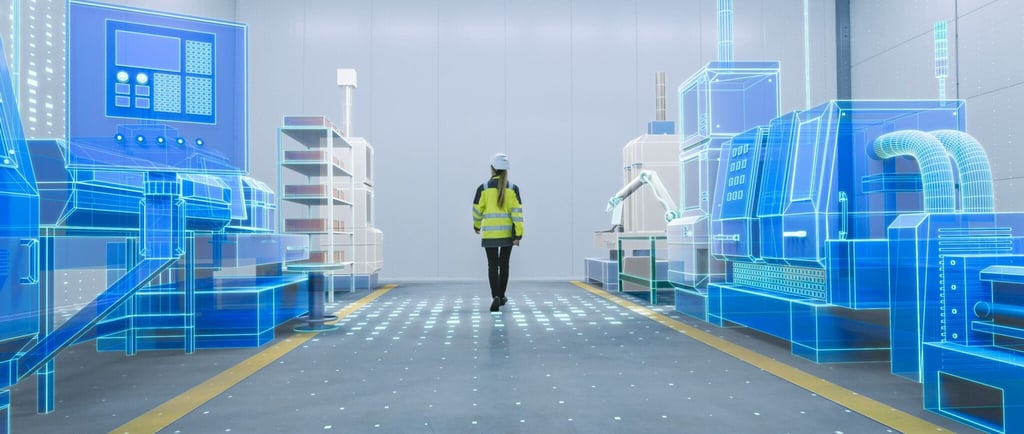The Impact of 3D Scanning on the Manufacturing Industry
3D SCANNERS
7/21/20244 min read


Introduction to 3D Scanning Technology in Manufacturing
3D scanning technology has emerged as a pivotal innovation in the manufacturing industry, revolutionizing the way manufacturers capture and utilize physical data. At its core, 3D scanning involves the precise measurement and digital capture of the dimensions and surface details of an object. This is typically achieved through the use of laser or structured light scanning devices, which generate detailed and accurate 3D models.
The significance of 3D scanning in manufacturing cannot be overstated. By converting physical objects into digital formats, manufacturers can streamline various processes, from design and prototyping to quality control and production. The ability to capture exact dimensions and intricate surface data ensures that every aspect of a component can be analyzed and replicated with high precision. This reduces the margin for error and accelerates the development cycle.
Technological advancements have significantly enhanced the accessibility and efficiency of 3D scanning for manufacturers. Modern 3D scanners are more compact, user-friendly, and cost-effective than their predecessors. Innovations in software algorithms have also improved the speed and accuracy of data processing, enabling real-time visualization and analysis. These advancements have democratized 3D scanning, making it a viable option for a broader range of applications within the manufacturing sector.
The transformative potential of 3D scanning technology is evident in its diverse applications. From reverse engineering and rapid prototyping to tool and die making, 3D scanning facilitates a more agile and adaptable manufacturing environment. It allows for the seamless integration of physical and digital workflows, thereby enhancing overall efficiency and productivity.
In conclusion, the introduction of 3D scanning technology marks a significant milestone in the evolution of manufacturing processes. By offering unprecedented accuracy and efficiency, 3D scanning is poised to play a crucial role in the future of manufacturing, driving innovation and competitiveness in the industry.
Applications of 3D Scanning in Manufacturing
In the manufacturing industry, 3D scanning has emerged as a transformative technology with a plethora of applications. One of the primary uses of 3D scanning is in prototype creation. By capturing precise measurements and intricate details of physical objects, manufacturers can quickly generate accurate digital models. These models can then be utilized to create prototypes, enabling iterative testing and refinement before the final product is developed. This significantly reduces the time and cost associated with traditional prototyping methods.
Another critical application of 3D scanning is reverse engineering. This process involves scanning an existing product to create a CAD model, which can then be analyzed and modified to enhance design or functionality. This is particularly beneficial in the automotive and aerospace industries, where maintaining and improving legacy components is essential. For instance, automotive manufacturers often use 3D scanning to modernize old parts, ensuring compatibility with newer models while maintaining the original design's integrity.
Quality control analysis is yet another domain where 3D scanning proves invaluable. By comparing the scanned data of manufactured parts against original design specifications, manufacturers can identify deviations and defects with high precision. This ensures that the final products meet stringent quality standards and reduces the likelihood of costly recalls. In the consumer goods industry, for example, 3D scanning is used to verify the dimensional accuracy of products such as home appliances, ensuring they fit perfectly into designated spaces.
3D scanning also plays a pivotal role in accelerating production times and increasing output. By streamlining the design, prototyping, and quality assurance processes, manufacturers can bring products to market more swiftly. Additionally, the high level of accuracy obtained through 3D scanning contributes to improved overall product quality, reducing material waste and enhancing customer satisfaction. In summary, the versatility and benefits of 3D scanning make it an indispensable tool in modern manufacturing, driving innovation and efficiency across various industries.
Future Trends and Innovations in 3D Scanning for Manufacturing
The future of 3D scanning in the manufacturing industry holds immense potential, driven by ongoing advancements in technology. One of the most significant trends is the enhancement of scanner resolution and speed. As manufacturers demand higher precision and quicker turnaround times, new 3D scanners are being developed with improved accuracy and faster data acquisition capabilities. These advancements will enable more detailed and rapid inspections, ensuring that quality control processes are both efficient and effective.
Another key trend is the integration of 3D scanning with other cutting-edge technologies such as Artificial Intelligence (AI) and the Internet of Things (IoT). By incorporating AI, 3D scanners can analyze and interpret data more intelligently, identifying defects and suggesting corrective actions in real-time. This seamless integration can lead to predictive maintenance and automated quality assurance, significantly reducing downtime and production costs. Additionally, IoT connectivity allows for the remote monitoring and control of 3D scanning systems, further enhancing operational efficiency.
The development of portable and affordable 3D scanning devices is also poised to make a substantial impact on the manufacturing industry. Portable scanners bring flexibility to the production floor, enabling on-the-spot inspections and measurements without the need for stationary equipment. As these devices become more cost-effective, smaller manufacturers will gain access to advanced scanning technologies, leveling the playing field and fostering innovation across the industry.
Despite these promising advancements, several challenges and limitations need to be addressed. Ensuring the accuracy and reliability of 3D scanning data in various environmental conditions remains a critical concern. Additionally, the integration of 3D scanning systems with existing manufacturing processes can be complex and may require significant investment in infrastructure and training. Overcoming these hurdles is essential to fully realize the transformative benefits of 3D scanning in manufacturing.
Looking ahead, the ongoing evolution of 3D scanning technology promises to revolutionize manufacturing processes. By continuing to improve resolution, speed, and integration capabilities, and by making these technologies more accessible, the manufacturing industry can achieve higher levels of precision, efficiency, and innovation. The future of 3D scanning in manufacturing is bright, with limitless possibilities for enhancement and growth.
